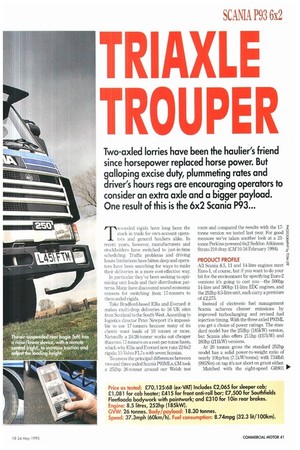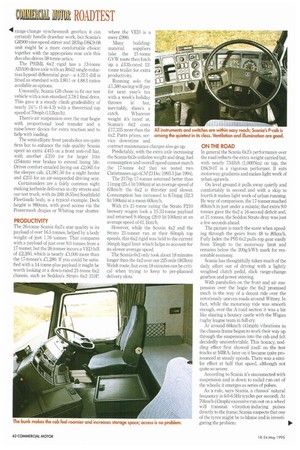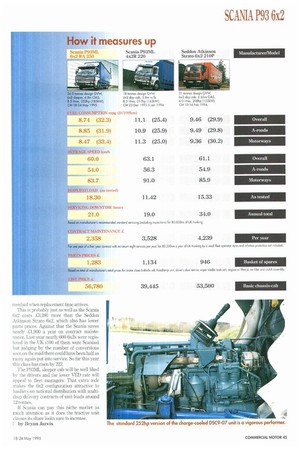TR It)(1.
Page 43

Page 44

Page 46

Page 47

If you've noticed an error in this article please click here to report it so we can fix it.
TROUPER
Two-axled lorries have been the haulier's friend since horsepower replaced horse power. But galloping excise duty, plummeting rates and driver's hours regs are encouraging operators to consider an extra axle and a bigger payload. One result of this is the 6x2 Scania P93...
Two-axled rigids have long been the stock in trade for own-account operators and general hauliers alike. In recent years, however, manufacturers and stockholders have switched to just-in-time scheduling. Traffic problems and driving hours limitations have bitten deep and operators have been searching for ways to make their deliveries in a more cost-effective way
In particular they've been seeking to optimising unit loads and their distribution patterns. Many have discovered sound economic reasons for switching from 17-tonners to three-axled rigids.
Take Bradford-based Ellis and Everarcl: it makes multi-drop deliveries to 16 UK sites from Scotland to the South West. According to logistics director Peter Newport it's impossible to use 17-tonners because many of its clients want loads of 10 tonnes or more. Naturally a 24/26-tormer works out cheaper than two 17-tonners on a cost-per-tonne basis, which why Ellis and Everard now runs 22 6x2 rigids; 15 Volvo FL7s with seven Stanias.
To assess the principal differences between two and three-axled Scania P93MLs, CM took a 252hp 26-tormer around our Welsh test
route and compared the results with the 17tonne version we tested last year. For good measure we've taken another look at a 21tonne Perkins-powered 6x2 Seddon Atkinson Strato 210 dray (CM10-16 February 1994).
PRODUCT PROFILE
All Scania 8.5, 11 and 14-litre engines meet Euro-1, of course, but if you want to do your bit for the environment by specifying Euro-2 versions it's going to cost you—the 500hp 14-litre and :380hp 11-litre EDC engines, and the 252hp 8.5-litre unit, each carry a premium of £2,275.
Instead of electronic fuel management Scania achieves cleaner emissions by improved turbocharging and revised fuel injection timing. With the three-axled P93ML you get a choice of power ratings. The standard model has the 252hp (185kW) version, but Scania also offers 211hp (157kW) and 283hp (211kW) versions.
At 26 tonnes gross the standard 252hp model has a solid power-to-weight ratio of nearly 10hp/ton (7,1kW/tonne); with 7341bft (995Nm) on tap it's not short on grunt either.
Matched with the eight-speed GR801
11 range-change synchromesh gearbox it can certainly handle drawbar work, but Scania's GR900 nine-speed stirrer and 283hp DSC9-08 unit might be a more comfortable choice: together with the appropriate rear axle this duo also drives 38-tonne art ics.
The P93ML 6x2 rigid has a 13-tonne ADA90 drive axle with an R642 single-reduction hypoid differential gear—a 422:1 duff is fitted as standard with 3.80:1 or 4.88:1 ratios available as options.
Unusually, Scania GB chose to fit our test vehicle with a non-standard 3/8:1 final drive. This gave it a steady climb gradeability of nearly 24% (1-in-4.2) with a theoretical top speed of 70mph (112km/h).
There's air suspension over the rear bogie with proportional load transfer and a raise/lower device for extra traction and to help with loading.
The semi-elliptic front parabolics are quite firm but to enhance the ride quality Scania spent an extra £415 on a front anti-roll bar, with another £310 for for larger 10in (254mm) rear brakes to extend lining life. Driver comfort entailed laying out £2,065 for the sleeper cab, £1,08150 for a night heater and £255 for an air-suspended driving seat.
Curtainsiders are a fairly common sight making kerbside deliveries in city streets and our test truck, with its 28ft (8.55m) Southfield Fleetloada body, is a typical example. Deck height is 980mm, with good access via the Powermesh drapes or Whiting rear shutter.
PRODUCTIVITY The 26-tonne Scania 6x2's star quality is its payload of over 16.5 tonnes, helped by a body weight of just 1.76 tonnes. That compares with a payload of just over 9.0 tonnes from a 17-tonner, but the 26-tonner incurs a VED bill of £2,260, which is nearly £1,000 more than the 17-tonner's £1,280. If you could be satisfied with a 14 tonne-plus payload it might be worth looking at a down-rated 21-tonne 6x2 chassis, such as Seddon's Strato 6x2 210P, where the VED is a mere £990.
Many building.
material suppliers take the 21-tonne GVW route then hitch up a £135-rated 12tonne trailer for extra productivity.
Running solo the £1,380 saving will pay for next year's tax with a week's holiday thrown in but, inevitably, there's a catch. Whatever weight it's rated at, Scania's 6x2 costs £17,335 more than the 4x2. Parts prices, service downtime and contract maintenance charges also go up.
Predictably, with the extra axle increasing the Scania 6x2s unladen weight and drag, fuel consumption and overall speed cannot match the 17-tonne 4x2 that we tested two Christmases ago (CM23 Dec 1993-5 Jan 1994).
The 217hp 17-tonner returned better than 11mpg (25.4 lit/100km) at an average speed of 63krn/h: the 6x2 is thirstier and slower. Consumption has increased to 81mpg (323 lit/100km) at a mean 60km/h.
With it's 21-tonne rating the Strato P210 brewery wagon took a 1533-tonne payload and returned 9.46mpg (29.9 lit/100km) at an average speed of 61.1km/h.
However, while the Scania 4x2 and the Strato 21-tonner ran at their 60mph top speeds, this 6x2 rigid was held to the current 56mph legal limit which helps to account for its slower average speed.
The Scania 6x2 only took about 18 minutes longer than the 4x2 over our 225-mile (363km) Welsh route, but even 18 minutes can be critical when trying to keep to pre-planned delivery slots. ON THE ROAD In general the Scania 6x2's performance over the road reflects the extra weight carried but, with nearly 7341bft (1,000Nm) on tap, the DSC9-07 is a vigorous performer. It eats motorway gradients and makes light work of urban sprawls.
On level ground it pulls away quietly and comfortably in second and with a skip to fourth it makes light work of urban running. By way of comparison, the 17-tonner reached 80km/h in just under a minute; that extra 9.0 tonnes gave the 6x2 a 16-second deficit and, at 21 tonnes, the Seddon Strata dray was just a few seconds ahead.
The picture is much the same when speeding through the gears from 48 to 80km/h. Fully laden the P93 6x2 pulls top gear easily from 35mph to the motorway limit and remains below the 200g/kWh mark for reasonable economy.
Scania has thoughtfully taken much of the daily effort out of driving with a lightly weighted clutch pedal, slick range-change gearbox and power steering.
With parabolics on the front and air suspension over the bogie the 6x2 promised much in the way of a decent ride over the notoriously uneven roads around Witney. In fact, while the motorway ride was smooth enough, over the A-road section it was a bit like sharing a bouncy castle with the Wigan rugby league team in full cry.
At around 66krn/h (41mph) vibrations in the chassis frame began to work their way up through the suspension into the cab and felt decidedly uncomfortable. This bouncy, nodding effect first showed itself on the test tracks at MIRA; later on it became quite pronounced at steady speeds. There was a similar effect at half that speed, although not quite so severe.
According to Scania it's unconnected with suspension and is down to radial run-out of the wheels; it emerges as series of pulses.
As a rule, says Scania, a chassis' natural frequency is 6.0-6.5Hz (cycles per second). At 70krn/h (43mph) excessive run-out on a wheel will transmit vibration-inducing pulses directly to the frame; Scania suspects that one of the tyres might be to blame and is investigating the problem. The 5.4m-wheelbase 6x2 takes body lengths up to 9.0m: with a 20.8m turning circle, route planners will need to be aware of the manoeuvring space needed for certain deliveries. Fortunately, as well as improving fraction the trailing axle's raise/lower capability will also help cope with tight confines.
Braking power is first rate for normal road use although the drive axle locked up during full-blooded, all-anchor stops from 48 and 60km/h on MIRAs test tracks.
Mind you, it would be reassuring to have a warning horn that could alert outsiders, unlike Scania's squeaky device which is more likely to entice lascivious dolphins.
CAR COMFORT Scania offers the lower-spec, lower-priced P. cab with its hand-wind windows and a mechanically sprung seat to entice fleet owners. There's easy access to the cloth covered driver's seat, which offers clear views to the front and sides.
All the instruments and switches are within easy reach, including the engine cut-out switch, but the P93 remains one of the few trucks that lacks a key-operated engine stop.
Scania's single bunk P-cab is comfortable enough and with the extra insulation beneath it noise levels are among the lowest in its class—at 80km/h they're down to 71dB(A) rising to 73.5dl3(A) at maximum motorway speed. Later this year sleeper versions will have a D1LC Eberspacher fitted as standard.
The cab is well ventilated and illuminated, and no less restrictive than a day version, but with the extra space behind the driver it seems roomier inside. The day cab is short on storage but the sleeper offers extra space beneath the bunk.
Scania's well-run-in demonstrator came with a number of extras aimed at enticing likely buyers when disposal time comes along. They include an external sun visor costing .C130 and an adjustable steering column, for £280.
SUMMARY Scania's P93ML 6x2 certainly has enough virtues to win friends in a growing niche market. A powerful, torquey engine gives a reasonable performance; body/payload is a hefty 18.3 tonnes, and there's the promise of a good residual when replacement time arrives.
This is probably just as well as the Scania 6x2 costs .0,280 more than the Seddon Atkinson Straw 6x2, which also has lower parts prices. Against that the Scania saves nearly J:1.900 a year on contract maintenance. Last year nearly 600 6x2s were registered in the UK (100 of them were Scanias) but judging by the number of conversions seen on the road there could have been half as many again put into service. So far this year this class has risen by 222.
The 1'931111.. sleeper cab will be well liked by the drivers and the lower VED rate will appeal to fleet managers. That extra axle makes the 6x2 configuration attractive to hauliers on national distribution with multidrop delivery contracts of unit loads around 12 tonnes.
if Scalia can pay this niche market as much attention as it does the tractive unit classes its share looks sure to increase.
by Bryan Jarvis




















































































































































